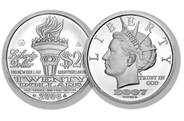Four years ago, I wrote an article for Silver Monthly titled “Hyperinflation Meltdown: Is It Inevitable?” I answered the titular question in the affirmative but offered no guidance on the precise timing of when the “hyperinflationary crash” — what Ludwig von Mises called a “crackup boom” — would hit. Mises himself predicted the inevitable collapse of the USSR in 1921, but he also acknowledged that timing the Soviet system’s bust with any degree of certainty was humanly impossible.
My “Hyperinflation” article from 2012 has been hailed as a “classic,” and it was recently sent out to Silver Monthly‘s 5,000+ email subscribers. In retrospect, the article’s tone is a bit overly apocalyptic (probably an understatement), but I wholeheartedly stand by its core theses:
- The true definition of “inflation” is an increase in the money supply, not rising prices (which are but a symptom of inflation);
- Hyperinflation has therefore already occurred, even if it hasn’t yet shown up in consumer prices; and
- The “crackup boom” that will result in the total destruction of the U.S. dollar and likely end of the U.S. empire is inevitable — it’s only a question of when it will happen; therefore
- Traditional investing strategies — i.e., a “60/40” portfolio of stocks and bonds — will not work.
You don’t need to read (or re-read) my 2012 piece to make use of this article — and this isn’t simply a rehashing or updating of the earlier piece. The 2012 article’s focus was on preparing for a global-financial catastrophe, while this article suggests a core savings strategy designed to increase your individual economic security, regardless of external factors.
What Are Core Savings?
“Core savings” are the savings prudent people should hold before they engage in more speculative investments. An investor bears uncertainty and risk in pursuit of increasing his future purchasing power, while a saver wants to “ex out” as much uncertainty and risk as possible in order to maintain (not grow) the purchasing power of his savings. This means savers need to make their savings as unlike investments as possible.
The most obvious risk savers face is the risk that inflation will cause the purchasing power of their savings to decline (i.e., “inflation risk“). A potential solution is to save precious-metal coins instead of cash, but doing so presents deflation risk — the risk that the purchasing power cash could increase rather than decrease, in which case the saver would have been better off holding cash than bullion.
Most readers are likely to assess deflation risk as being much lower than inflation risk, and I would agree — but such a view is speculative and belongs in the realm of investing; not saving. Investing is what we do with our assets in excess of our core savings, so we want our core savings to be as fully hedged as possible against both inflation and deflation, just in case we’re wrong in our investment views.
Physical vs. Digital
So far we’ve divided non-consumptive uses for our resources into savings and investments, and further subdivided savings into inflation– and deflation-hedged assets — which we’ll explore in more detail below. But before we can go any further, we need to address the pros and cons of holding our savings physically versus holding them digitally.
By “physically held,” I mean anything that’s in your possession, on your property, or directly accessible by you. This includes only things you can literally hold — there’s a place for bitcoin and other crypto-currencies in my core savings plan, but on the digital side of the physical/ digital divide.
ETFs (“exchange-traded funds”) that serve as a proxy for precious metals (i.e., the GLD ETF) or currencies (i.e., UUP for the U.S. dollar, FXE for the euro) can be part of your core savings plan, too, but these must be considered digital holdings. Cash in the bank or in a brokerage account, etc., is also considered digital.
While we want to be as equally hedged between inflation and deflation scenarios as possible, the precise physical/ digital composition of your savings is up to you — although I strongly recommend a minimum of 50% of your assets from each basket (inflation hedges and deflation hedges) be held physically. Digitally held assets have the benefit of convenience, which is very important when dealing with other users in markets, but they also run extra risks in the event of a serious financial crisis.
Inflation Hedges
The most obvious inflation hedges are gold and silver bullion. Although their monetary value and (more importantly) purchasing power can be volatile in the short term, precious metals have a long-term track record for protecting their holders against inflation. And while metals prognosticators have differing views on which is the better bet — gold or silver — those views are better left for investing, not savings. For purposes of core saving, I recommend an equal distribution, as measured in current purchasing power, between gold and silver.
Bitcoin and other crypto-currencies are also potential inflation hedges. Indeed, with silver prices unable to break out the past couple of years, there’s a case to be made that bitcoin has supplanted silver’s traditional role as second-fiddle to gold. Of course, bitcoin’s purchasing power has been exceptionally volatile over its short lifespan, and it can only be held electronically — but if you’re a true believer in the crypto-revolution, I can bless as much as 25% of your total core savings (i.e., half of the inflation-hedged basket) in bitcoin and its peers (with the remaining half of the inflation-hedged basket held entirely in physical assets).
The least-obvious inflation hedge is probably the best of all: Future consumables. The great Austrian economist Ludwig von Mises had the great insight that people only hold cash in the face of uncertainty — if humans were endowed with unerring foresight, there would never be a reason to save at all. Of course, humans do not have perfect foresight, but we can accurately predict at least some of our future needs and wants — buying them now is a hedge against prices rising in the future. Buying in bulk can result in your savings stretching even further.
Deflation Hedges
Cash is the obvious deflation hedge. We hold cash because we can’t perfectly anticipate our future needs, and buying some items in advance — i.e., perishables — would be fruitless (pun intended). Mises acknowledged this but said that in a world of perfect certainty, farmers and other producers could simply strike deals for future delivery of as-of-yet unproduced goods in a way that matched the time preferences of buyers and sellers. This, of course, is an academic argument — in real life, we need to hold cash.
A second potential deflation-hedge is the early servicing of debt. Debt-management strategies are beyond the scope of this article, but suffice it to say paying down fixed-rate debt early is particularly wise in a deflation scenario, wherein each fixed payment becomes dearer than the last.
At least half of your deflation-hedged basket should be physically held, and this generally means bills and coins of your domestic currency. Some amount of currency diversification may make sense, but the vast majority should be in U.S. dollars (for Americans).
Implementing the Strategy
The best thing about my core savings strategy is that anyone whose income exceeds his expenses can begin implementing it right now. There are no minimums to get started. But one thing I haven’t touched on thus far is: How much core savings do you need?
This, of course, is dependent on too many variables for me to address here — your current financial status, your age, your income, your goals, your risk tolerance, ad infinitum. All that can be said for certain is that the greater the level of your core savings, the greater your financial security — and this can allow you to be more speculative with your investments that are outside core savings.
If you already have the resources, then reallocating at least three months’ worth of your current living expenses (sans income tax) into core savings is probably wise. Six months is likely wiser; two years even better — but it all depends on your risk tolerance (among myriad other factors).
So let’s imagine your monthly living expenses — excluding income taxes — are $2,400. Three months’ expenses would be $7,200 in current purchasing power. This means you’d want to have $3,600 worth of purchasing power in inflation-hedged savings, and an equal amount in deflation-hedged savings.
For your inflation-hedged basket, at least half of the $3,600 in value should be held physically. This can include gold and silver coins, as well as future consumables. The remainder — between 0% and 50% of the basket — can be held in “digital” inflation hedges, such as crypto-currencies and precious metals ETFs (if you’re so inclined).
The same rules apply for your deflation-hedged basket: At least $1,800 of your cash savings (half of $3,600) should be held outside the banking system — just in case. In the event of a crisis, the ATMs may not be dispensing the money you need. “Bail-ins” and other financial chicanery are also future possibilities.
Maintaining the Strategy
You should “audit” your core savings periodically — whether that means monthly, quarterly, semiannually, or annually is up to you. The audit needs to determine the current purchasing-power value of your inflation- and deflation-hedged baskets, as well as their makeup in terms of physical and digital holdings, so that you can make any necessary adjustments.
If, for example, the value of the dollar has gone up (as unlikely as that may sound), then your deflation-hedged basket will have greater purchasing power than your inflation-hedged basket — and in this case, you should trim your deflation-hedged holdings and replace them with inflation-hedged assets to balance out the two baskets. This will have a “dollar-cost averaging” affect in addition to keeping you hedged.
Assuming your income exceeds your expenses — and if it doesn’t, you need to fix that right away — you should be adding to your core savings regularly. As your savings build, you’ll feel more confident to engage in more speculative investing — exactly when you should begin doing so is up to you and dependent on your tolerance for risk. The more core savings you have, the greater risk you can afford to take on, though.
Conclusion
Few (if any) investment strategies are right for everyone, but my core savings strategy comes close. The strategy isn’t for you if:
- Your risk tolerance is so high that the idea of having your own inflation- and deflation-hedged safety net sounds like nothing but a waste of potential investment resources;
- Your time preference is so high that consuming today is more important than planning for tomorrow;
- You have a religious faith in the U.S. government’s ability to maintain the purchasing power of the greenback; or
- You have a religious faith (i.e., 0% doubt) that the U.S. dollar is going to crash in the next couple of years.
For everyone else: The strategy is designed to work in the event of a crash or in the event that a personal crisis hits you before a global one destroys the economy as we know it.



